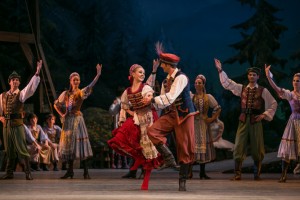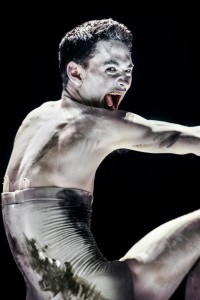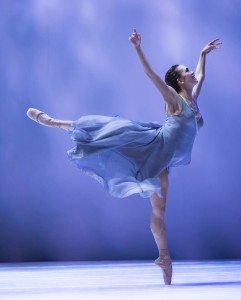Making the Move: Why Europe beckons North American dancers - Vancouver Ballet Society
- Home
- Features 2015 - 2019
- Making the Move: Why Europe beckons North American dancers

by Gigi Berardi
Small cafés, narrow streets, bicycles, baguettes, state support for education, music and dance — Europe seems to have it all, and North American dancers are moving there to join small ensembles, state-supported companies, circuses and cabarets.
Just what are the advantages and the challenges of making the move? As Danielle Gould, currently with Hungarian National Ballet, admits, “Working abroad is all about learning curves, both positive and negative. Really, it’s about new cultures and languages to learn.”

Gould, 23, was on the fast track to push through, work hard and join a top Canadian ballet company, with her sights set on the National Ballet of Canada. She started attending its Toronto school at age 10, and also trained at home in Vancouver with Goh Ballet Academy. Gould completed her Royal Academy of Dance syllabus training and achieved her Solo Seal Award, leading her to compete at the Genée International Ballet Competition in 2010.
A scholarship in 2011 from the Youth America Grand Prix ballet competition gave Gould the opportunity to train in Europe at the John Cranko School of Stuttgart Ballet, which, she says, “was a wonderful introduction to the dance scene of Europe. Working in Stuttgart made it possible to travel and explore European culture and lifestyle. It has certainly proved to be a happy decision.” For Gould, the main attraction was, first, the repertory, and then the beautiful opera houses. After her training in Stuttgart, Gould was invited to join the Hungarian National Ballet as a company member.
Hawaiian-born Gregory Lau, 22, trained in New York at LaGuardia High School of Music & Art and Performing Arts, and later attended the Juilliard School. During his first year there, he travelled to Europe to audition for Nederlands Dans Theater 2, the junior division of the main company, and accepted a contract. “The Netherlands was always a place I was interested in and knew would provide motivation for my artistic growth,” he recalls. Many of Lau’s friends at Juilliard also went on to dance in Europe.

“It is interesting to discuss our actual experiences abroad compared to our idealized dreams of what the ‘European dance scene’ is. We imagine endless opportunities to work with famous choreographers, constant one-on-one attention. Opportunities and attention are certainly there, but not necessarily consistently,” says Lau.
Canadian Paxton Ricketts, who trained in the dance program at Vancouver’s Arts Umbrella, also went to The Hague, in the Netherlands, to audition for NDT 2. Ricketts, 22, says of the company: “They do work by some of the best choreographers in the world. It’s exhilarating to be immersed in such a place.” At first, Ricketts was concerned about a language barrier. “But, it turns out, since the company is so international, all the classes and rehearsals are in English. The Hague is the same, actually. It is such an international city and everyone seems to speak English.”
Noelani Pantastico, 36, another Hawaiian-born dancer, is a product of training at the Pacific Northwest Ballet School and years of dancing with the company. In 2008, after being with the Seattle-based Pacific Northwest Ballet for 11 years, Pantastico was looking for a change. Guest choreographer Jean-Christophe Maillot had cast her as one of two dancers taking on the female lead in his version of Roméo et Juliette, and she ended up dancing in all nine performances due to an injury of the other Juliet. She caught the eye of Maillot and of the coaching team from his company, Les Ballets de Monte Carlo, and decided she wanted to explore more of Maillot’s choreography in Monaco.

“I didn’t expect anything going into Monte Carlo; honestly, I didn’t know what to expect,” says Pantastico. “I had a rather complacent attitude and, at 28, thought, ‘If I don’t leave now I will never be able to see other dancers, coaches, companies.’” She also wanted to focus on types of work other than the familiar Balanchine-based and mixed-contemporary repertory at Pacific Northwest Ballet.
For all four dancers, the artistic appeal of dancing in Europe is huge. Sometimes dancers want to work with specific choreographers or even sets of coaches, as did Pantastico at Monte Carlo. The process of coaching and artistic development can be more individualistic in Europe, and can add an additional dimension to dancers’ work, either on an emotional or physical level. For Pantastico, the Monte Carlo coaching directed at her emotional vulnerability allowed her to work on connecting intention to individual movement. “It has made dancing more interesting for me, and hopefully it transfers through to the audience.”
Lau was drawn, in particular, to the diversity of the Netherlands repertory. “At a certain point, Hofesh Shechter, Crystal Pite and Sharon Eyal were all in the same building working on their own creations,” he says. “That just never happens! It has been such a blessing to be able to watch their processes with NDT dancers and then see the final results.”
Travel and touring, too, is a big draw — and it’s something European-based companies do particularly well. “Since Europe is so condensed,” says Ricketts, “we are able to tour a lot to many different countries.” The touring, however, adds wear and tear on the body, with uneven and uncertain stage floors, gruelling schedules with little time for recovery, jet lag, and constant changes in drinking water and hotels, all of which can add up to a lot of injuries. But for many, it is worth it.
Les Ballets de Monte Carlo is mostly a touring company, with only two or three programs a year at home in Monaco. Tours to Israel, Syria, Japan and Cuba have given Pantastico opportunities to travel she says she would not have had otherwise.
Dancers may be drawn to the historical and cultural richness of a particular region. This appealed to Ricketts, but it wasn’t the major driver for his move. Europe is a beautiful and historically rich place, he says, “but when you’re pursuing a dance career you focus more on the companies you want to work for rather than the cities you want to live in. Location may affect your decision, but there are other things that play a bigger role.”
For Lau, “the main attraction to dance in Europe is the history and support the art has here.” Government financial support to freelance artists or established companies creates a strong foundation for creativity to flourish.
North Americans may also make the move to Europe simply because there are more options. “To a degree,” says Ricketts, “commercial dance has a larger audience in North America, and concert dance has a larger audience in Europe. Neither is better than the other; they are two very different worlds. So the European scene has an appeal to some dancers who prefer the concert style.”
Europe’s preference for concert dance tends to produce full houses with loyal audiences, many performances, and the opportunity to dance a lot and to dance a varied repertoire. Even small cities can feature opera houses and theatres with resident ballet and opera companies, as well as orchestras. Jobs may still be difficult to get, but there is a perception of more opportunities and, according to Gould, it is not uncommon for North American dancers to do a large audition tour of Europe since there are so many theatres to audition for. For Gould, because Hungarian National Ballet is a state-run ballet company and opera house, with two theatres to perform in — the Hungarian State Opera House and the more modern Erkel Theatre — the repertoire and number of large ballet productions in a season is exceptional. This has allowed Gould to dance both corps de ballet and soloist roles, and to learn a large and varied repertoire in just three years.
Dancers also notice big differences in the audiences in different countries. “How the audience reacts and interacts with your performance deeply affects what you do,” explains Ricketts. “There is very much a relationship built between the two. It’s amazing how different the same performance feels with audiences from Hungary or France or Sweden.”
Change is inevitable; it’s what attracted this quartet of dancers to Europe. It’s also what brought Pantastico home: she re-joined Pacific Northwest Ballet in the fall of 2015. She felt that she had attained what she could working with a single choreographer, adding, “I have changed as an artist and feel it is all for the better. My performances show a different maturity, and the Seattle audiences are very appreciative.”
Gould’s plans for the future include expanding her repertoire and “developing even more as an artist, both technically and artistically.” She has her sights set on a promotion and hopes to see doors opening in new directions, including developing her passion for choreographing. As Gould says, “This, for me, is an enriching experience that later on in life I will look back on and think, these are the experiences that made me an artist.”
Lau has just been promoted to Nederlands Dans Theater, the main company. His commitment is clear: “The dancers here are truly inspirational. I think great things can stem from being surrounded by such knowledgeable artists, so I am looking forward to learning from all of them.” NDT2 is designed to keep its young dancers for three years, and Ricketts, after two years with the group, is looking forward to what the next season brings.
All four dancers want to put themselves in settings where they are constantly being challenged. This holds for the studio and for day-to-day living — Europe seems to provide an enticing place to do just that.

